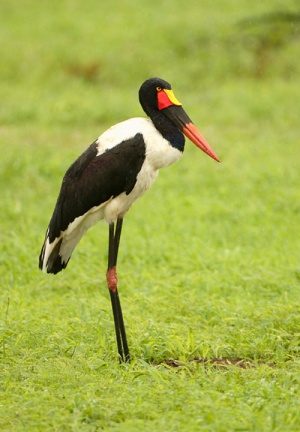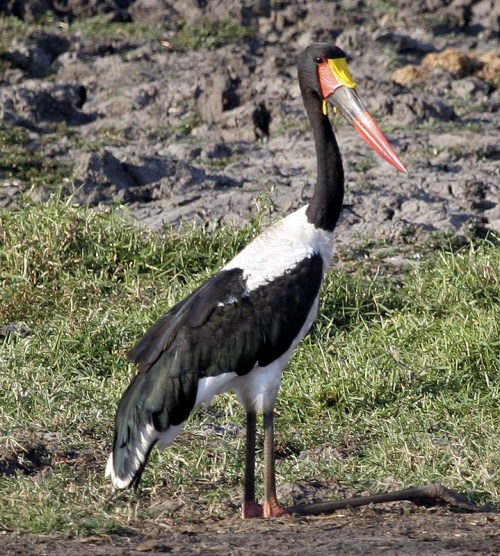(Taxonomy) |
(Attempt to disguise copied text. Pictures of Female, Juvenile & flight. Distribution expanded. References) |
||
| Line 1: | Line 1: | ||
| − | [[Image:14479SBS.jpg|thumb| | + | [[Image:14479SBS.jpg|thumb|500px|right|Male (brown eye)<br />Photo by {{user|TwoBoy|TwoBoy}}<br />[[Kruger National Park]], [[South Africa]], October 2004]] |
;[[:Category:Ephippiorhynchus|Ephippiorhynchus]] senegalensis | ;[[:Category:Ephippiorhynchus|Ephippiorhynchus]] senegalensis | ||
==Identification== | ==Identification== | ||
| − | 150 cm high. The male is larger and heavier than the female | + | 150 cm high. The male is larger and heavier than the female<br /> |
| + | *Iridescent black head, neck, back, wings, and tail | ||
| + | *White body and primaries | ||
| + | *Red bill | ||
| + | **Very large | ||
| + | **Black band | ||
| + | *Yellow frontal shield (the “saddle”) | ||
| + | *Black legs and feet | ||
| + | *Pink knees<br /> | ||
| + | Sexes similar<br /> | ||
| + | '''Female''' has a yellow iris<br /> | ||
| + | '''Male''' iris is brown, small yellow wattles at base of bill<br /> | ||
| + | '''Juveniles''': brownish-grey plumage | ||
==Distribution== | ==Distribution== | ||
| − | Sub-Saharan [[Africa]] | + | [[Image:34172Saddle Bil - small.jpg|thumb|300px|right|Female (yellow eye)<br />Photo by {{user|Patrick+Cloete|Patrick Cloete}}<br />Punda Maria, [[Kruger National Park]], [[South Africa]] December 2005]] |
| + | Sub-Saharan [[Africa]]<br /> | ||
| + | '''Western Africa''': [[Senegambia]], [[Senegal]], [[The Gambia]], [[Guinea-Bissau]], [[Guinea]], [[Mali]], [[Sierra Leone]], [[Liberia]], [[Ivory Coast]], [[Burkina Faso]], [[Ghana]], [[Togo]], [[Benin]], [[Nigeria]], [[Niger]], [[Chad]], [[Cameroon]], [[Central African Republic]], [[Equatorial Guinea]], [[Gabon]], [[DRC]] and [[Angola]]<br /> | ||
| + | '''Eastern Africa''': [[Sudan]], [[Eritrea]], [[Ethiopia]], [[Djibouti]], [[Somalia]], [[Kenya]], [[Uganda]], [[Rwanda]], [[Burundi]], [[Tanzania]], [[Zambia]], [[Mozambique]] and [[Malawi]]<br /> | ||
| + | '''Southern Africa''': [[Namibia]], [[Botswana]], [[Zimbabwe]], [[South Africa]], [[KwaZulu-Natal]] and [[Swaziland]] | ||
==Taxonomy== | ==Taxonomy== | ||
| − | + | This is a [[Dictionary_M-S#M|monotypic]] species<sup>[[#References|[1]]]</sup>. | |
==Habitat== | ==Habitat== | ||
| − | + | Dams and large rivercourses, flood plains, wetlands and swamps. | |
==Behaviour== | ==Behaviour== | ||
| − | It builds a large, deep stick nest in a tree | + | ====Breeding==== |
| + | It builds a large, deep stick nest in a tree. The 1 or 2 white eggs are incubated for 30-35 days; the chicks fledge 70 - 100 days later. | ||
====Diet==== | ====Diet==== | ||
The diet includes fish, frogs and crabs, but also on young birds, and other land vertebrates. | The diet includes fish, frogs and crabs, but also on young birds, and other land vertebrates. | ||
| + | <gallery> | ||
| + | Image:21502811 female Saddle-billed Stork in flight 640x480 copy.jpg|Female<br />Photo by {{user|nkgray|nkgray}}<br />Letaba, [[Kruger National Park]], [[South Africa]] October 2006<br />Click image for larger version | ||
| + | Image:14479stk1.jpg|Juvenile<br />Photo by {{user|TwoBoy|TwoBoy}}<br />[[Kruger National Park]], [[South Africa]], October 2004<br />Click image for larger version | ||
| + | </gallery> | ||
| + | ==References== | ||
| + | #{{Ref-Clements6thDec09}}#Avibase | ||
| + | #Wikipedia | ||
| + | {{ref}} | ||
==External Links== | ==External Links== | ||
{{GSearch|Ephippiorhynchus+senegalensis}} | {{GSearch|Ephippiorhynchus+senegalensis}} | ||
[[Category:Birds]] [[Category:Ephippiorhynchus]] | [[Category:Birds]] [[Category:Ephippiorhynchus]] | ||
Revision as of 21:16, 16 October 2010
- Ephippiorhynchus senegalensis
Identification
150 cm high. The male is larger and heavier than the female
- Iridescent black head, neck, back, wings, and tail
- White body and primaries
- Red bill
- Very large
- Black band
- Yellow frontal shield (the “saddle”)
- Black legs and feet
- Pink knees
Sexes similar
Female has a yellow iris
Male iris is brown, small yellow wattles at base of bill
Juveniles: brownish-grey plumage
Distribution

Photo by Patrick Cloete
Punda Maria, Kruger National Park, South Africa December 2005
Sub-Saharan Africa
Western Africa: Senegambia, Senegal, The Gambia, Guinea-Bissau, Guinea, Mali, Sierra Leone, Liberia, Ivory Coast, Burkina Faso, Ghana, Togo, Benin, Nigeria, Niger, Chad, Cameroon, Central African Republic, Equatorial Guinea, Gabon, DRC and Angola
Eastern Africa: Sudan, Eritrea, Ethiopia, Djibouti, Somalia, Kenya, Uganda, Rwanda, Burundi, Tanzania, Zambia, Mozambique and Malawi
Southern Africa: Namibia, Botswana, Zimbabwe, South Africa, KwaZulu-Natal and Swaziland
Taxonomy
This is a monotypic species[1].
Habitat
Dams and large rivercourses, flood plains, wetlands and swamps.
Behaviour
Breeding
It builds a large, deep stick nest in a tree. The 1 or 2 white eggs are incubated for 30-35 days; the chicks fledge 70 - 100 days later.
Diet
The diet includes fish, frogs and crabs, but also on young birds, and other land vertebrates.
Female
Photo by nkgray
Letaba, Kruger National Park, South Africa October 2006
Click image for larger versionJuvenile
Photo by TwoBoy
Kruger National Park, South Africa, October 2004
Click image for larger version
References
- Clements, JF. 2009. The Clements Checklist of Birds of the World. 6th ed., with updates to December 2009. Ithaca: Cornell Univ. Press. ISBN 978-0801445019.
- Avibase
- Wikipedia
Recommended Citation
- BirdForum Opus contributors. (2024) Saddle-billed Stork. In: BirdForum, the forum for wild birds and birding. Retrieved 25 April 2024 from https://www.birdforum.net/opus/Saddle-billed_Stork






